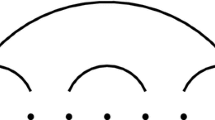Abstract
The stochastic matrix method is used to describe the statistical processes that take place when a glass is formed. We stress the physical features of the model and the relevancy of the hypotheses made. The theory is applied to various types of binary and ternary chalcogenide glasses, and the predictions of the model are compared with the experimental data. We also reveal the influence of doping on the transition temperature. The theory is extended to the case of growing a disordered solid on a substrate.
Similar content being viewed by others
References
Kerner, R., inAtomic Diffusion in Disordered Materials: Theory and Applications, Balkanski, M. and Elliott, R.J., Eds., World Scientific, 1998, pp. 25–35.
Zallen, R.,The Physics of Amorphous Solids, New York: John Wiley, 1983.
Elliot, R.,Physics of Amorphous Materials, New York: John Wiley, 1989.
Kerner, R., Bennemann, K.H., and Penson, K., Model for the Growth of Fullerenes from Carbon Vapour,Eur. Lett, 1992, vol. 19, pp. 263–368.
Kerner, R. and Micoulaut, M., On the Glass Transition Temperature in Covalent Glasses,J. Non-Cryst. Solids, 1997, vol. 210, pp. 298–305.
Barrio, R., Kerner, R, Micoulaut, M., and Naumis, G.G., Evaluation of the Concentration of Boroxol Rings in Vitreous Boron Oxide by the Stochastic Method,J. Phys.: Condens. Matter., 1997, vol. 9, pp. 9219–9234.
Feltz, A., Aust, H., and Blayer, A., Glass Formation and Properties of Chalcogenide Systems: XXVI. Permittivity and Structure of Glasses As-Se and Ge-Se,J. Non-Cryst. Solids, 1983, vol. 55, pp. 179–190.
Feng, X., Bresser, J., and Boolchand, P., Direct Evidence for Stiffness Threshold in Chalcogenide Glasses,Phys. Rev. Lett, 1997, vol. 78, pp. 4422–4425.
Di Marzio, E.A., inStructure and Mobility in Molecular and Atomic Glasses, O’Reilly, J.M. and Goldstein, M., Eds.,Ann. N. Y.Acad. Sci., 1981, vol. 371, pp. 1–12.
Tatsumisago, M., Halfpap, B.L., Green, J.L., Lindsay, S.M., and Agnell, C.A., Fragility of Ge-As-Se Glass Forming Liquids in Relation to Rigidity Percolation and the Kauzmann Paradox,Phys. Rev. Lett, 1990, vol. 64, pp. 1549–1553.
Sreeram, A.H., Swiler, D.R., and Varshneya, A.K., Gibbs-Di Marzio Equation to Describe the Glass Transition Temperature Trends in Multicomponent Chalcogenide Glasses,J. Non-Cryst. Solids, 1991, vol. 127, pp. 287–297.
Phillips, J.C., Topology of Covalent Non-Crystalline Solids: I. Short-Range Order in Chalcogenide Alloys,J. Non-Cryst. Solids, 1979, vol. 34, p. 153.
Kerner, R. and Naumis, G., Stochastic Matrix Description of Glass Transition,J. Phys.: Condens. Matter, 2000, vol. 12, pp. 1641–1648.
Micoulaut, M. and Naumis, G.G., Simple Rules for the Prediction of the Glass Transition Temperature in Network Glasses,Eur. Lett., 1999, vol. 47, pp. 568–574.
Ciridhar, A. and Mahadevan, S., TheT g versus Z Dependence of Glasses of the Ge-In-Se System,J. Non-Cryst. Solids, 1992, vol. 151, pp. 245–252.
Saffarini, G., On Topological Transitions and Chemical Ordering in Network Glasses of the Ge-Ga-S System,Solid State Commun., 1994, vol. 91, pp. 577–580.
Hudalla, C, Weber, B., and Eckert, H., Glass Formation and Local Structure in the Ternary System P-Se-Al: A Solid State NMR Studies,J. Non-Cryst. Solids, 1998, vol. 224, pp. 69–74.
El-Fouly, M.H., Maged, A.F., Amer, H.H., and Morsy, M.A., Thermal Induced Transformations in Glassy Chalcogenides Si-Te-As-Ge,J. Mater. Sci., 1990, vol. 25, p. 2264.
Chambouleyron, I., personal communication.
Author information
Authors and Affiliations
Additional information
The article was submitted by the author in English.
Rights and permissions
About this article
Cite this article
Barrio, R.A., Naumis, G.G. Models of disorder. Glass Phys Chem 26, 325–330 (2000). https://doi.org/10.1007/BF02731993
Issue Date:
DOI: https://doi.org/10.1007/BF02731993




